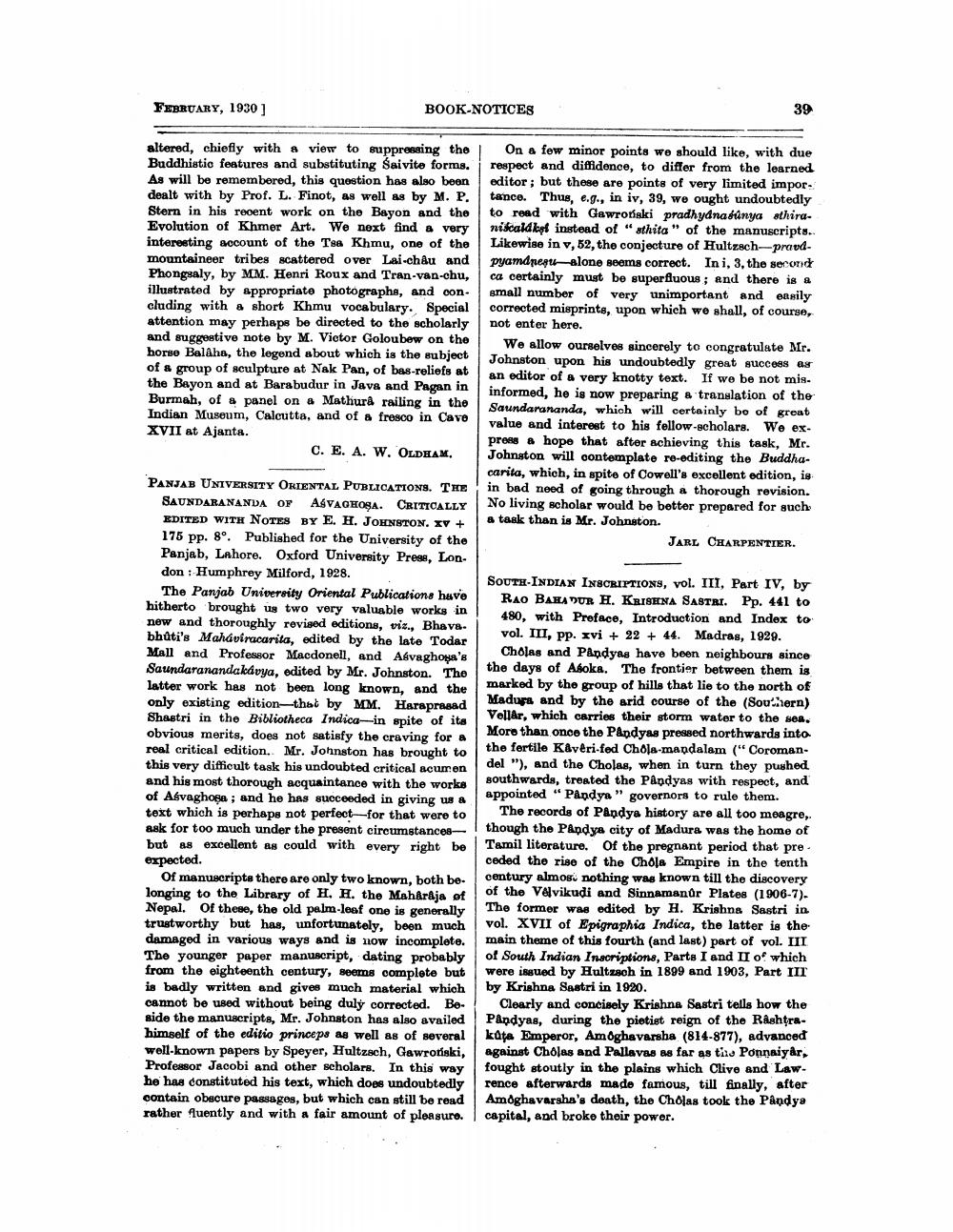________________
FEBRUARY, 1930]
BOOK-NOTICES
altered, chiefly with a view to suppressing the Buddhistic features and substituting Saivite forms. As will be remembered, this question has also been dealt with by Prof. L. Finot, as well as by M. P. Stern in his recent work on the Bayon and the Evolution of Khmer Art. We next find a very interesting account of the Tsa Khmu, one of the mountaineer tribes scattered over Lai-châu and Phongsaly, by MM. Henri Roux and Tran-van-chu, illustrated by appropriate photographs, and concluding with a short Khmu vocabulary. Special attention may perhaps be directed to the scholarly and suggestive note by M. Victor Goloubew on the horse Balâha, the legend about which is the subject of a group of sculpture at Nak Pan, of bas-reliefs at the Bayon and at Barabudur in Java and Pagan in Burmah, of a panel on a Mathura railing in the Indian Museum, Calcutta, and of a fresco in Cave XVII at Ajanta.
C. E. A. W. OLDHAM,
PANJAB UNIVERSITY ORIENTAL PUBLICATIONS. THE SAUNDARANANDA OF ASVAGHOSA. CRITICALLY EDITED WITH NOTES BY E. H. JOHNSTON. XV + 175 pp. 8°. Published for the University of the Panjab, Lahore. Oxford University Press, London Humphrey Milford, 1928.
The Panjab University Oriental Publications have hitherto brought us two very valuable works in new and thoroughly revised editions, viz., Bhava. bhûti's Mahaviracarita, edited by the late Todar Mall and Professor Macdonell, and Aévaghosa's Saundaranandakávya, edited by Mr. Johnston. The latter work has not been long known, and the only existing edition-that by MM. Haraprasad Shastri in the Bibliotheca Indica-in spite of its obvious merits, does not satisfy the craving for a real critical edition. Mr. Johnston has brought to this very difficult task his undoubted critical acumen and his most thorough acquaintance with the works of Asvaghosa; and he has succeeded in giving us a text which is perhaps not perfect for that were to ask for too much under the present circumstancesbut as excellent as could with every right be expected.
Of manuscripts there are only two known, both be. longing to the Library of H. H. the Maharaja of Nepal. Of these, the old palm-leaf one is generally trustworthy but has, unfortunately, been much damaged in various ways and is now incomplete. The younger paper manuscript, dating probably from the eighteenth century, seems complete but is badly written and gives much material which cannot be used without being duly corrected. Beside the manuscripts, Mr. Johnston has also availed himself of the editio princeps as well as of several well-known papers by Speyer, Hultzsch, Gawroński, Professor Jacobi and other scholars. In this way he has constituted his text, which does undoubtedly contain obscure passages, but which can still be read rather fluently and with a fair amount of pleasure.
39
On a few minor points we should like, with due respect and diffidence, to differ from the learned editor; but these are points of very limited importance. Thus, e.g., in iv, 39, we ought undoubtedly to read with Gawroński pradhydnasúnya athiraniscaldkst instead of "sthita" of the manuscripts.. Likewise in v, 52, the conjecture of Hultzsch-pravdpyamdnesu -alone seems correct. In i, 3, the second ca certainly must be superfluous; and there is a small number of very unimportant and easily corrected misprints, upon which we shall, of course, not enter here.
We allow ourselves sincerely to congratulate Mr. Johnston upon his undoubtedly great success as an editor of a very knotty text. If we be not misinformed, he is now preparing a translation of the Saundarananda, which will certainly be of great value and interest to his fellow-scholars. We express a hope that after achieving this task, Mr. Johnston will contemplate re-editing the Buddhacarita, which, in spite of Cowell's excellent edition, is in bad need of going through a thorough revision. No living scholar would be better prepared for such a task than is Mr. Johnston.
JARL CHARPENTIER.
SOUTH-INDIAN INSCRIPTIONS, Vol. III, Part IV, by RAO BAHADUR H. KRISHNA SASTRI. Pp. 441 to 480, with Preface, Introduction and Index to vol. III, pp. xvi + 22+ 44. Madras, 1929.
Cholas and Pandyas have been neighbours since the days of Asoka. The frontier between them is marked by the group of hills that lie to the north of Madura and by the arid course of the (Southern) Vellar, which carries their storm water to the sea. More than once the Pandyas pressed northwards into the fertile Kâvêri-fed Chola-mandalam ("Coromandel "), and the Cholas, when in turn they pushed southwards, treated the Pandyas with respect, and appointed "Pandya " governors to rule them.
The records of Pandya history are all too meagre,. though the Pandya city of Madura was the home of Tamil literature. Of the pregnant period that preceded the rise of the Chola Empire in the tenth century almost nothing was known till the discovery of the Velvikudi and Sinnamanûr Plates (1906-7)The former was edited by H. Krishna Sastri in vol. XVII of Epigraphia Indica, the latter is the main theme of this fourth (and last) part of vol. III of South Indian Inscriptions, Parts I and II of which were issued by Hultzsch in 1899 and 1903, Part III by Krishna Sastri in 1920.
Clearly and concisely Krishna Sastri tells how the Pandyas, during the pietist reign of the Rashtrakúta Emperor, Amoghavarsha (814-877), advanced against Cholas and Pallavas as far as the Ponnaiyar, fought stoutly in the plains which Clive and Lawrence afterwards made famous, till finally, after Amoghavarsha's death, the Cholas took the Pandya capital, and broke their power.




